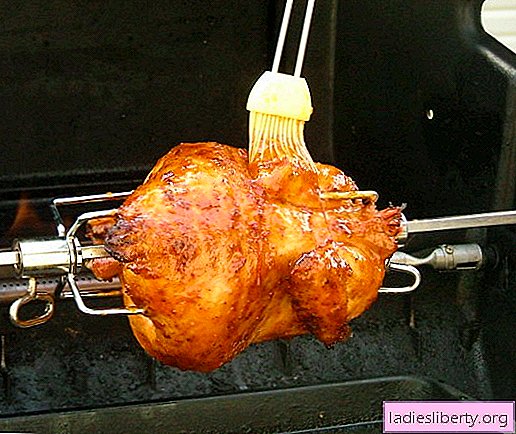
Childbirth - This is a difficult physiological process, which is associated with a large physical and psychological load on the woman’s body and a certain degree of risk to her health.
Full recovery of the body occurs not earlier than 6-8 weeks after the birth of the baby.
One of the natural manifestations of cleansing the body is blood discharge from the uterus, which begins immediately after childbirth.Very often, the discharge is similar to heavy menstruation and comes out with clots. Many women, not knowing the causes of clots after childbirth, experience fear, considering them exclusively as a pathology. However, in most cases this is not so. Consider how much discharge and clots are normal and what to do with blood clots after childbirth, when they threaten the health of a young mother.
Causes of blood clots after childbirth in the uterus
During childbirth, the uterus undergoes a much greater load and changes than all other organs. After the birth of the fetus, the placenta leaves - the fetal membranes, the placenta and the umbilical cord. The remains of the placenta, mucus and blood clots continue to go out throughout the postpartum period. Blood clots are also called lochia. Normally, by the end of the first month after birth, they become scarce and transparent.
The cause of blood clots, especially when they become very intense, is breastfeeding the baby. During the process, the uterus contracts strongly. This contributes to its rapid cleansing and recovery. During feeding, many women, especially multiparous, feel moderate pain of a pulling nature in the abdomen, which is evidence of uterine contractions. In such cases, blood clots that are secreted from the uterus are considered a natural physiological process of the uterus returning to its prenatal state.
After 2-3 days, women are usually prescribed an ultrasound examination of the uterus. It is necessary to make sure that the process of cleansing the genital organ is carried out in accordance with the norm. There are frequent cases when the doctor discovers the remains of the membranes and large blood clots. In this case, clots are an alarming sign, since favorable conditions are created for the penetration and reproduction of pathogenic bacteria. In severe cases, this can lead to endometritis (inflammation of the inner layer of the uterus).
Fear is also caused by those cases when, a few days after the birth, the lochia significantly decreases, or even completely stops. The reason for this phenomenon can be a large blood clot, which prevents the free exit of secretions from the uterus. It also happens that clots do not appear immediately, but after several "clean" days.
If such phenomena are accompanied by pain, an unpleasant odor from the vagina and an increase in body temperature, this may indicate the onset of the inflammatory process. In such cases, you should immediately contact your doctor who knows for sure what to do with blood clots in the uterus that are "not in a hurry" to go out.
What to do with blood clots after childbirth and poor contraction of the uterus
Normally, the uterus, one day after the birth, is at the navel level and drops 2 cm daily. There are times when the presence of blood clots also indicates a poor contraction of the genital organ. Among the factors affecting the rate of contraction, it is customary to single out the woman's age, size of the fetus, childbirth took place naturally or with the help of a cesarean section, how successfully the process of breastfeeding is carried out.
The accumulation of blood clots stretches the uterine membrane, throws it backwards, thereby preventing the discharge of secretions. The uterus is poorly contracted if there are fibromyomas in its body, after a multiple pregnancy, if the born child weighs more than 4 kg. There are many ways that can improve uterine contractility:
• earlier rising and movement after childbirth (in the event that they passed without complications);
• performing special postpartum gymnastics;
• applying the baby to the chest in the first half hour after childbirth;
• feeding the baby not by the hour, but on demand;
• frequent abdomen;
• applying ice or a cold heating pad to the lower abdomen, which reduces smooth muscle;
• regular emptying of the bladder;
• eating foods that improve intestinal motility;
• combating constipation in order to reduce pressure on the uterus;
• administration of oxytocin intramuscularly.
For a healthy woman whose birth has passed on time and without pathologies, the above measures are enough to ensure that the release of blood clots gradually decreases. But even if after discharge, the young mother feels satisfactory, she should take the time and visit an ultrasound to make sure that the discharge process is normal. This is especially important if an ultrasound scan was not performed at the maternity hospital for any reason. In the event of a sluggish contraction of the uterus and a large number of clots, treatment is prescribed, and sometimes curettage of the uterus.
What to do with blood clots after childbirth: cleaning the uterus
As noted above, the presence of clots is far from always the basis for curettage. If immediately after birth there are doubts about the complete exit of the placenta, a manual cleaning of the uterus is performed. It is also necessary after cesarean section.
With pathological discharge of blood clots, antibiotic therapy is prescribed for women. In this case, the fact of lactation is taken into account. In order not to interfere with the process of natural feeding, women are recommended to feed the baby before taking the medicine. Oxytocin is also prescribed through a dropper or intramuscularly. The drug is taken under the supervision of a doctor, who for several days will monitor the size of the uterus and the success of the reduction. Water pepper extract has good effectiveness.
To cleanse the uterus, vacuum aspiration is performed. Many women are very afraid of this procedure, rightly considering it unpleasant and painful. In order to eliminate discomfort, vacuum aspiration is performed under general anesthesia. The duration of the procedure does not exceed 20 minutes. The postoperative period is under the supervision of a doctor. Within two weeks after curettage, certain warnings should be observed:
• strictly follow the rules of personal hygiene;
• do not take a bath, use a shower;
• Do not swim in the pools, river or sea;
• do not go to baths and saunas;
• do not use vaginal swabs;
• do not douche;
• exclude any weight lifting;
• minimize physical activity and exercise;
• exclude sexual intercourse (intimacy is not recommended earlier than three to four weeks after birth).
After cleaning the uterus from blood clots, the discharge may increase, which is not surprising, because the uterus turns into an open wound. But after a week they become moderate, and then, in accordance with the norm, become brown.
Blood clots: folk remedies
With a weak contraction of the uterus, which is the cause of blood clots after childbirth, well-proven folk remedies have proven themselves well. They include:
• nettle - 3 tbsp. spoons brew 0.5 l of boiling water, insist and drink 100 mg three times a day;
• white calendula flowers - 2 tbsp. spoons pour 0.5 liters of boiled cooled water, insist night and take several times a day;
• shepherd’s bag - 3-4 tablespoons of grass are brewed in a glass of boiling water, the mixture is wrapped and insisted for 3-4 hours;
• birch leaves - dried leaves are poured with boiling water, add baking soda, insist in a warm place, drink a glass 3 times a day.
The allocation of blood clots after childbirth is a completely normal physiological phenomenon, which should not be scared. At the same time, throughout the entire postpartum period, you need to listen very carefully and look closely at your body so as not to miss the symptoms that may indicate negative processes in the uterus. Caring for a small child, which takes a lot of time and effort, should not be an excuse for a woman's indifferent attitude to her health condition, because a baby needs a healthy mother so much!











